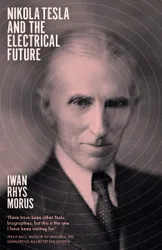This is a biography of the inventor and scientist Nikola Tesla, who was a key figure during the development of electricity as a practical technology in the late 19th century. This book puts Tesla’s life and work in the context of a time when electricity was starting to be put to practical use on both sides of the Atlantic. As someone born and educated in Europe, who emigrated to the United States, Tesla was able to participate in developments happening in both places.
We learn about Tesla’s early life before moving to America, working briefly for Thomas Edison’s company, and then becoming an inventor in his own right. The book paints Tesla as a showman as well as an inventor; he had learned from Edison that an inventor also had to be a self-promoter. His early inventions were significant in the development of alternating current as the dominant form of electricity transmission, and as a well-known inventor he became very influential as a public figure. However, later in life he had some failed projects, lost money, and became significantly less influential. Developments like the transmission of radio waves passed him by; at the time he was much more focused on the idea of wireless energy transmission.
This book is very focused on certain topics: the electrical inventions and discoveries being made in the second half of the 19th century, the inventors making and promoting those inventions, and their reception with the press and public. There are lots of quotes from reporters and commentators, and events are described as they would have been at the time. This is history as reportage, with fairly minimal interpretation, and not much comparison with what we now understand, or how things turned out in the present day.
When Edison and Westinghouse (both of whom Telsa worked with at different times) were battling it out to decide whether alternating or direct current would be the dominant technology for electricity distribution, as a reader I know that AC won out because that’s how electricity is sent into my home today. But there are cases where I think some modern perspective would have helped to illuminate things more. For example, most scientists at the time believed that electromagnetic waves were transmitted through a substance called the Ether (sometimes spelled as Aether). There is a section of the book which describes how the effectiveness of James Clerk Maxell’s equations describing these waves were taken as proof that the ether existed. Although we now know that the ether does not exist and that these waves travel in a vacuum, this isn’t mentioned in the book. Personally I would like to have had things put into context a bit more. It seems remarkable to me that so much technology was developed based on a misconception about how electromagnetism works, and I think this would have been an interesting topic to cover in the book.
At the time Tesla was around, there was a lot of speculation about what electrical technologies could be developed in the future. Tesla himself engaged in this speculation, as a way to promote his own inventions, raise investment in his business, and to generally keep himself in the press and the public eye. Many of these speculative ideas have been realised in our present day world, but many haven’t. It’s left to the reader to figure out which is which. I kept expecting the author to comment on which ideas worked out and which didn’t, and to expand on why. It would be fascinating to have some analysis of why electronic communication and computing power developed beyond the wildest dreams of anyone in the 19th century, yet wireless power transmission is more or less limited to phone charging pads and electric toothbrushes, at least in my everyday experience.
I would also have liked a bit more science in this book. It is written by a historian, so it’s understandable that he wouldn’t be trying to write a science book. But I didn’t get a grasp on what Tesla actually invented, how it worked or why it was useful. His contributions weren’t really put into context, and they are not as well known as Thomas Edison’s inventions. There are some slightly confusing phrases that could have been explained. At one point, the book mentions electricity of “high intensity” but it wasn’t clear to me whether this meant voltage or current. Some explanation of why AC was considered to be better for long distance transmission of electricity, and why we transmit electricity at high voltages but low currents (to reduce the resistance and hence the energy loss as heat) would have been welcome.
Maybe I just wanted this to be a slightly different book than it actually is; it’s a history book, not a science book. What you do get is a fascinating snapshot of the world of electrical invention, the characters involved, and how their work was received by the press and public at the time. It was a world where anything seemed possible, and what struck me was how many of the speculative ideas were eventually realised. I’ve found myself considering the electrical appliances and devices I use everyday in a new light as a result of reading this book.
